Anna Von Mertens: A whole world of connotations
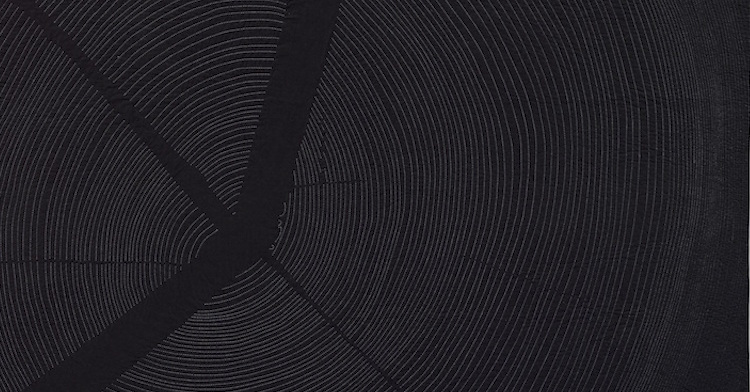
Anna is an artist who uses traditional quilting methods and textile processes, like hand dyeing and stitch together with digital technology to create stunning conceptual art. Her work is a combination of art, science and history and compels the viewer to contemplate what it means to be us.
Anna Von Mertens is the recipient of a 2010 United States Artists Simon Fellowship and a 2007 Louis Comfort Tiffany Foundation Biennial Award.
Her work is in the collections of the Museum of Fine Arts, Boston; Berkeley Art Museum; Smithsonian American Art Museum’s Renwick Gallery, RISD Museum; Allen Memorial Art Museum, Oberlin College; Robert Hull Fleming Museum, University of Vermont; and the International Quilt Study Center and Museum in Lincoln, Nebraska.
Von Mertens has had numerous solo exhibitions throughout the United States including the Berkeley Art Museum; Boston Center for the Arts; University Art Museum, Santa Barbara; Crisp-Ellert Art Museum, Flagler College; Mills College Art Museum; University Art Museum, Cal State Long Beach; University of San Francisco’s Thacher Gallery; Southern Exposure, San Francisco; Headlands Center for the Arts, Sausalito, CA; Elizabeth Leach Gallery, Portland, OR; Jack Hanley Gallery, San Francisco; and Sara Meltzer Gallery, New York.
Anna Von Mertens is represented by Elizabeth Leach Gallery, Portland, Oregon.
In this interview we learn about Anna’s day to day working processes, what drives her choices and, perhaps most importantly, who inspires her elaborate designs.
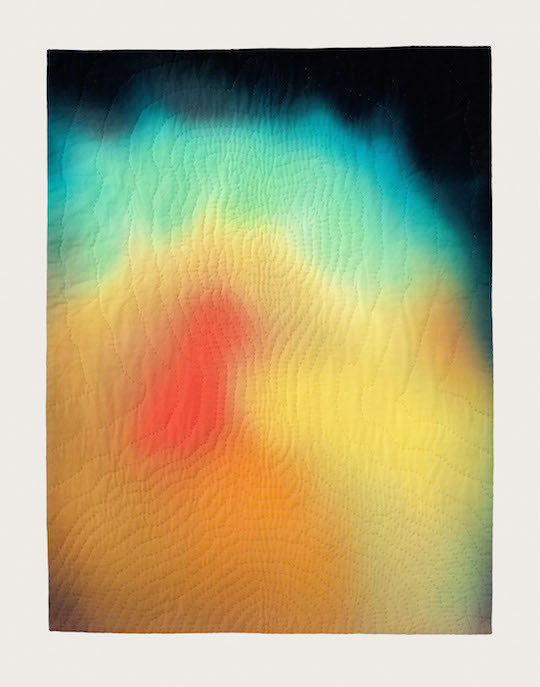
Anna Von Mertens: “Frida Kahlo’s aura, with Thorn Necklace and Hummingbird”
2009, 24 1/4″ x 18 1/2”, hand-dyed, hand-stitched cotton
The immediacy of the materials
TextileArtist.org: What initially attracted you to textiles as a medium?
Anna Von Mertens: I was working in more traditional media–drawing and printmaking–when I decided on a whim to make a quilt. It was two dollar dress day at the Salvation Army and I scooped up a bunch of dresses and started sewing. I think many people make one quilt in their life. And often that one feels like enough! I, on the other hand, was immediately ready to make the next one.
Part of it was the immediacy I felt in the materials. There was an intimacy there that drew you in. I realized if I had ideas I wanted to communicate that I could conceptually fold them into the quilt and the material itself would invite the viewer in.
Quilts obviously have a direct reference to the bed. And the bed brings a whole world of connotations: the home, relationships, the body, dreams. So if I worked with quilts I could use those connotations and build off of them, almost like a platform from which I could leap. I liked having that as a starting point, which is why in my early works I made what I called “bed sculptures” and showed my quilts in the form of a bed.
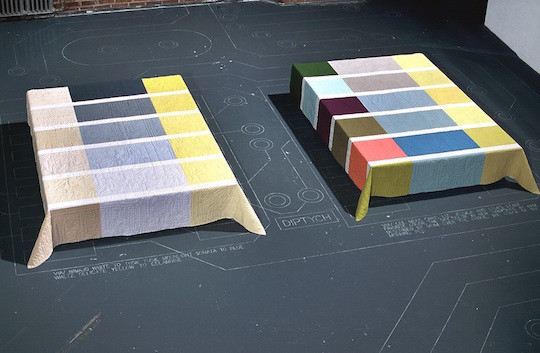
Anna Von Mertens: “Diptych Via/ Navajo White to Tusk Tusk, Moonlight Sonata to Blue Waltz, Delicate Yellow to Celandine, with Via/ Lee, Mom, Chris, Liz, Jessica and Lisa’s least favorite color, the New Hampshire sky color at 4 p.m. described by Mom over the phone, the color of my morning pee” 2000, 80″ x 60″ x 15″ (each), hand-dyed, hand-stitched cotton
And, more specifically, how was your imagination captured by hand dyed cotton?
I came to hand-dyeing quite simply out of necessity. I was working with verbal descriptions of color (people describing their least favorite color to me, or the color of the sky over the phone) and trying to recreate those descriptions as accurately as possible. I realized I could only get the color I wanted if I dyed it myself.
Once I learned the dyeing process, I quickly fell in love with creating color in that way. It is a slow alchemy where the color seems to surface out the fabric itself as you watch, which it actually does, as the dye chemically bond with the fibers. Working with color on such an intimate level makes you know color that much deeper. I’ve never gone back to buying fabric since!
From generation to generation
What or who were your early influences and how has your life/upbringing influenced your work?
While neither of my parents were artists (they are both teachers) they were always making things, my dad especially in his woodshop. I learned early the satisfaction of making things, and while my work does always have a conceptual starting point, it was important to me to anchor those ideas in an object. Giving ideas weight and a thing to help consider the idea feels very important to me. It allows the viewer to come at an idea from different angles, allows an idea to be heard in a different way.
I often think of how traditional quilts are handed down from generation to generation, and with it comes a story: your grandmother made this quilt for your mother’s wedding, or perhaps it was a pioneer quilt documenting a journey west. With the telling of the story, those ideas get embedded in the object and transform the object. I like to think the same thing happens with conceptual art.
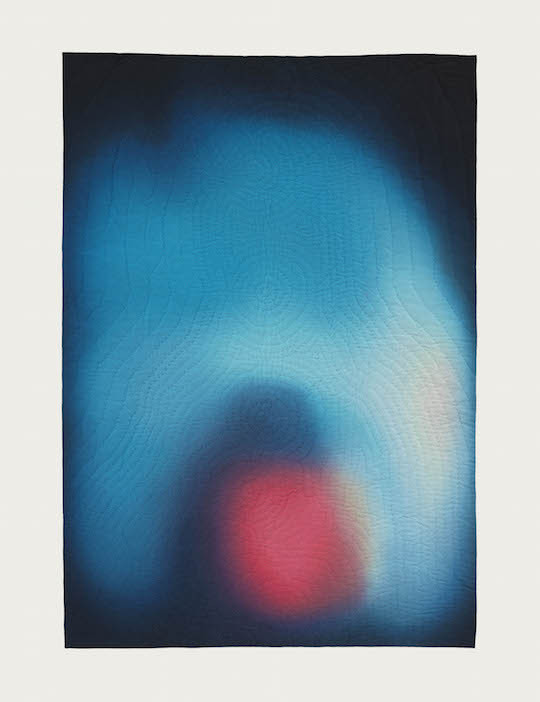
Anna Von Mertens: “Mona Lisa’s aura, after Leonardo da Vinci” 2009, 34 3/4″ x 25 3/4”, hand-dyed, hand-stitched cotton
What was your route to becoming an artist?
I knew I wanted to be an artist in first grade and have never wanted to be anything else. Part of it was that I could draw well, and there was a satisfaction in being able to represent what I saw. But I see now that my role as an artist to integrate diverse ideas, organize visually the world around me, and my desire for beauty have always been present in my life and have been tied to that first grader’s assuredness of wanting to be an artist.
How would you describe your work and where do you think it fits within the sphere of contemporary art?
I have always seen myself simply as a contemporary artist, I have not particularly identified as a textile artist. Ideas drive my work, and when I look at other artists who I identify with, they happen to not be textile artists. And yet, the textiles community provides a home base, a place where I feel understood, be it from a shared history or how ideas are communicated through the medium.
So I have straddled both worlds, trying to provide a context for my work that highlights its conceptual focus, but also appreciating how the textiles world has supported me. I’m not trying to change one world or the other, just accepting that I straddle both, and find that an interesting place to be. It is also an interesting place to watch how each world is shifting as they come together, influence one another, and diverge.
Do you use a sketchbook? If not, what preparatory work do you do?
I don’t have a sketchbook, I just think (and think and think) about a project before committing to it. I probably think too much! So often an idea is what drives the work, like the series where I showed the actual stars seen above violent moments in American history. I had the idea for that series, and then did a large amount of research around that idea. Once I actually sat down to make the work, the idea guided all of the aesthetic decisions so it was actually quite straightforward from there. I often work that way, where I have established a set of rules, or come up with a certain idea that guides (or at least feels like it is guiding) all of the decisions along the way. That helps me get out of my own way and just follow that trail.
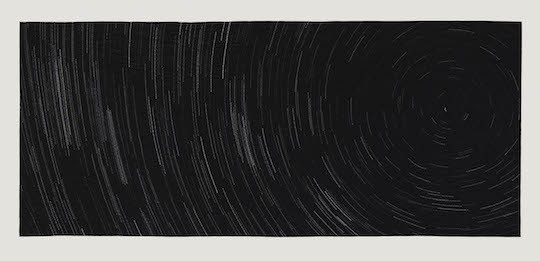
Anna Von Mertens: “6:01 pm until 7:05 pm, April 4, 1968, from the balcony of the Lorraine Motel in Memphis, Tennessee (looking in the direction the shots were fired)” 2006, 41″ x 97.5”, hand-stitched cotton
Committing to finishing the piece
Tell us about your process from conception to conclusion.
As I have said, I start with an idea. A recent body of work was a collaboration with scientists using their archives of tree ring specimens that document climate shifts through changes in tree growth with catastrophic human events such as the fall of the Roman empire. So I often spend many months in the research phase, looking at history, gathering images, making selections. Once that is all in place I can then start to translate this data into a stitch pattern that I project onto fabric. From there it is many months of stitching to see a series complete!
I like this cycle, the phase of coming up with an idea, researching that idea, giving it form, and then committing to finishing the piece. Each phase feels fresh at the beginning, and each phase is always challenging to complete!
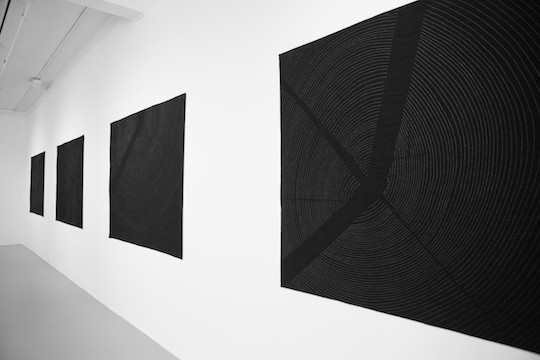
Anna Von Mertens: “Migrations, Invasions, Plagues and Empires” installation view, Boston Center for the Arts, Mills Gallery, 2013
What environment do you like to work in?
I work in a practical medium and I work in a practical environment. Currently my dye lab is in my basement, the least glamorous of all studios, as all you really need is an industrial sink and a large table. When I’m stitching I just work on an embroidery hoop so I can carry my work with me wherever I go. I’ve always appreciated that my medium is cheap, portable and able to be brought into the living room. It makes it a part of every day life which is then reflected in the work.
Simple is good!
What currently inspires you?
I hate to sound like a cliche, and I almost can’t believe I’m saying this, but my young children inspire me. They look at everything with such awe and openness and appreciation. It’s a good reminder. They also help me boil down to the basics, of trying to find my core interest in an idea and to keep things simple. Simple is good! So while having kids is exhausting and they do occasionally drive me bonkers, I also love them dearly, and yes, in that cheesy way, they inspire me.
Who have been your major influences and why?
While I only worked with this woman briefly, a memory has stayed with me over the years. Willia Ette Graham was an amazing quilter who lived in Oakland, CA and was in her nineties when I met her. She quilted many of Rosie Lee Thompkins patchwork quilts which became well-known and Ms. Graham was also was an amazing improvisational piecer herself.
One day when I visited her with a friend to show her what we had been working on and to see her hands at work, we convinced her to bring out quilts she had made. They were stacked up in a closet, a mountain of quilts, and she laid them on her bed one on top of the other.
One quilt in particular was very complicated in its piecing, and composed of just two colors. The fabric itself was extremely thick, which impressed me because the piecing was so complex. I asked her where the fabric came from and at first I didn’t understand her. But then I realized she was saying it was awning fabric—she had used a reversible industrial awning fabric that someone had given her to create this masterpiece. We laughed at the miracle of that!
Seeing those quilts laid out, each one as impressive as the next, I realized I was seeing a lifetime of quilts, a chronicle of time. That day has stayed with me and it is a good one to remember, how those hands day by day created those quilts with so much beauty, how evident it was how much they contained.
How has your work developed since you began and how do you see it evolving in the future?
My work has shifted over the years. In the beginning I was very committed to the form of the bed and all of the ideas that resonated there. But eventually I tired of those restrictions and started to think about the wall. The wall always felt like the enemy because it was the territory of painting. But when I realized the wall was about the act of looking I started to think about the act of stargazing as the quintessential form of looking and several years work sprung from that idea with the works feeling comfortable on the wall.
Recently I made a series of work that were simply hand-dyed fabric on a wooden stretcher (so yes, basically paintings!) I left the stitching behind for that series because I realized the work was simply about color and anything else would get in the way. Recently I’ve taken up a daily drawing practice. At times it felt hard to leave behind ways of working, and scary to start something new. But I’ve learned what is important will find its way back into my work. I also know the ways I have worked in the past will inform my current work. So even if I ended up making traditional paintings or some such thing, how I got to that place is different than if I simply started there.
When in doubt, keep working
What advice would you give to an aspiring textile artist?
It is the same advice I would give to any artist, including myself: stay in the studio. When in doubt, keep working.
It is not an easy or predictable road being an artist (something I come up against all the time) but when I make work I feel good about and have committed myself to, then it is easier to get out do the networking side of things. When you are ready to show your work, find a person that believes in you. Then build off that connection. Just take it step by step, it doesn’t have to happen all at once. But when in doubt, head back to the studio.
How do you go about choosing where to show your work?
Originally I was actually quite conscious about not showing my work in a textiles context. I didn’t even use the word quilt in my artist statement! I felt I had to have this very staunch viewpoint that my work was conceptual and that is what I wanted to highlight. It was obvious that the works were quilts, so I wanted to create a context where they were seen differently.
I have relaxed from that standpoint, in part because the art world has shifted and work that crosses categories is more welcomed and accepted. But I have also accepted that the work I make will be seen however it wants to be seen and that is not something I need to control. If seen in a textiles context it will be seen one way, if seen in a show where my work is the only textiles present it will be seen another. At the end of the day you just have to get back in the studio and make the work.
Where can readers see your work this year?
If you are in the Bay Area I am in a survey show at the Marin Community Foundation curated by Patricia Watts highlighting textile artists from the Bay Area. [http://fibershed2015.blogspot.com]
My work is also on display at the International Quilt Study Center & Museum at the University of Nebraska as part of their current permanent collection exhibition.
And this month my work is on view at Biola University in a show curated by Jeff Rau titled “Mortal Parts: Figures in the Abstract.”
My work can always be seen through my gallery, Elizabeth Leach Gallery, in Portland, Oregon. They have also just established an online viewing room where my work can be seen.
Also, information on my recent project at the Radcliffe Institute can be viewed here.
For more information please visit www.annavonmertens.com
Got something to say about the techniques, materials and processes used by this artist – let us know by leaving a comment below.

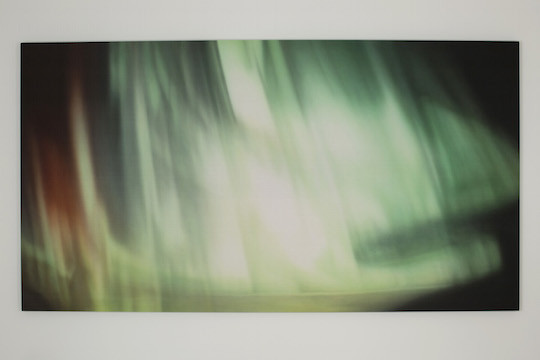
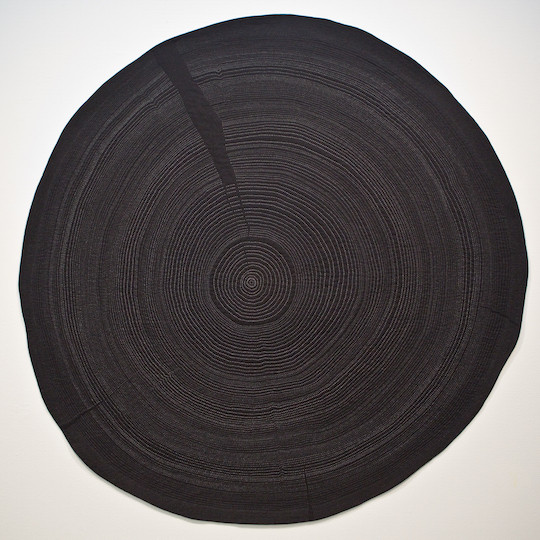















This work is refined down to its basics and therefore really elegant and sublime.
The work/ inspiration that informs Anna’s research helps her create works that to me are offering deep visual insights yet appear edited and restrained.
Thank you for interviewing this talented artist.